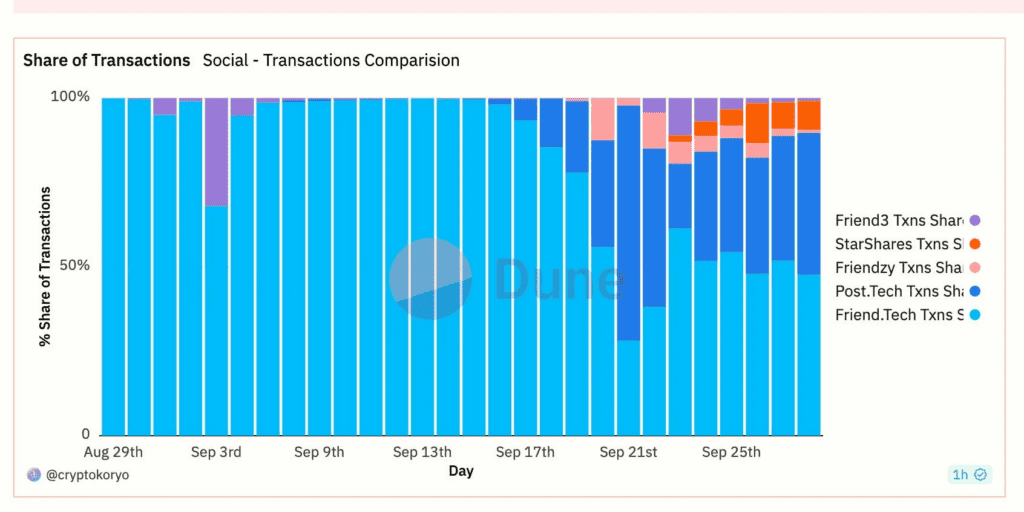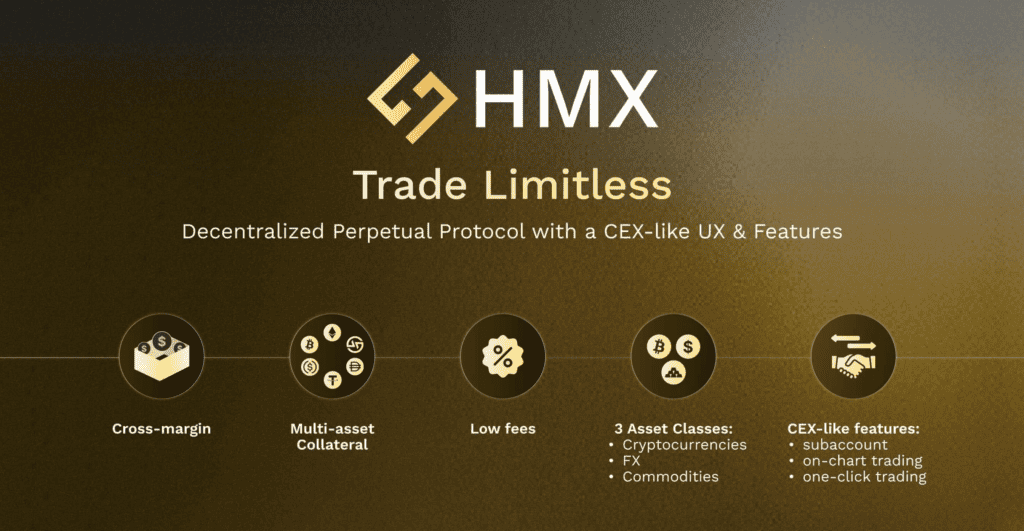
The highly anticipated Celestia airdrop is now live. It’s red panties night for everyone except Americans.
“Developers and address holders in the United States or other prohibited countries are not eligible for the Genesis Drop.”
Why? Regulations. And unfortunately, even your secret VPN won’t work in this case.
The regulators have once again protected US citizens from free money.
Thanks for nothing, Gary.
Here’s what we got today:
- Friend.tech frenzy. The copycats are here.
- Frax Finance Roadmap. Dive into one of the best roadmaps among DeFi protocols.
- Ethereum gas fee at yearly lows. And why are people making noise about it?
- Around the web. ThorChain has integrated Binance Smart Chain, Raft Finance released $RAFT tokenomics, and more.
Today’s email is brought to you by HMX Protocol.
The Friend.tech Frenzy
There haven’t been too many interesting things happening in Crypto lately. However, there has been one app making the degens go wild:
Friend.Tech.
What’s Friend.Tech? We’ve covered this a few times, but here’s a quick refresher. It’s a SocialFi application that allows anyone to issue “keys.” Two features make these “keys” special:
- They can be traded, and
- Holders acquire access to a private group chat with the key issuer. The theory is you’ll get exclusive alpha from the guys.
Whenever there’s a market leader, there will be “beta plays.” These are similar dapps that you could potentially make a higher ROI on.
And now, we are seeing a flood of Friend.tech copies. Every other chain is getting its own FT fork. Kinda reminds me of the OHM days where forks were popping up daily.

Here are the top Friend.Tech alternatives now:
1) Post.tech on Arbitrum: The differentiating factor is a Twitter-like user interface. Post.tech allows users to trade profiles and posts. And 5% of trading volume goes to shareholders. It is the most successful FT fork so far:
- More than 66k users
- Total protocol fees are USD 407k+
- USD 8+ million in cumulative volume
2) FanTech on Mantle: A major issue with Friend.tech was bots snatching keys of new accounts. FanTech introduced “Shares Generation Even” that prevents this issue. It also includes extra features like public/private posts, see accounts you follow on X, a stats page, etc.
3) Friendzy.gg on Solana: This eliminated the steep price increase associated with Friend.tech. Top Friend.tech shares go for USD 11k+. In contrast, shares of top accounts on Friendzy cost only around USD 10.
4) Alpha on Bitcoin: Its technical architecture is a bit complex (essentially: Bitcoin for finality, Trustless Computer for scaling, and Polygon for data storage). A referral program is also being built, allowing users to earn 1% on their invitees’ trading volume.
4) Star Shares on Avalanche: Creators can set their own subscription prices. There is also a plan to release features such as pay-to-view posts and video/audio integrations.
While it’s tempting to try to get a higher ROI, they do comes with risks. Rushed copycat products that try to capitalize on current trends may not be 100% secure.
Edgy’s take: First mover advantage is real in this sector due to the network effect. It’s the same reason why creating new dating apps or social networks is hard.
These new forks are only valuable if they convince influencers to jump ship.
And these influencers can’t jump platforms easily. The masses have already purchased the keys of major influencers on Friend.tech. And if they suddenly release new keys on other platforms, existing key holders may feel like they’ve been rugged.
Plus…influencers are lazy, man. You think they’re going to “give value” to multiple chatrooms?
But this doesn’t mean that other apps are dead on arrival. Each chain can have its own SocialFi application. They’ll need to innovate to attract users, like how Post.tech has a Twitter-like UI.
Bottom line: I’m already suspicious of the staying power of Friend.Tech after the airdrop happens. Going into the beta plays feel extremely risky. If you need a dopamine hit, then whatever. But I’d stay away.
A lesson that I learned from poker is never play bad hands because you’re bored.
HMX: Trade Limitless on a Decentralized Perpetual Protocol

Decentralized Perps was one of the hottest narratives last year, and it’s not slowing down anytime soon.
Now, there’s a new generation of innovative protocols.
At the forefront is HMX protocol, a next-generation Decentralized Perpetual exchange built on Arbitrum.
Here’s why it’s a trader’s heaven:
- Low fees: Enjoy the lowest trading fees in the industry (0.04% for BTC and ETH, 0.01% for FX, 0.05% for commodities, and 0.07% for other crypto).
- Multi-asset collateral: Use BTC, ETH, ARB, wstETH, and stablecoins as collateral to trade without needing to first convert them into a specific asset.
- Cross-margin collateral: Increase your capital efficiency and reduce the risk of liquidation with cross-margin positions.
- High leverage trading: Get up to 1000x leverage to capitalize on your market views.
- Subaccount support: Implement different trading strategies using different subaccounts – all under the same wallet address.
- 1-click trading: Enjoy a seamless decentralized trading experience enabled by account abstraction – simply input a PIN, no more signing transactions.
- Trade-to-earn: Trade at HMX and earn up to $150,000 in esHMX weekly!
And if you’re not interested in trading?
Then you can earn real yield by depositing assets into the HLP vault and become a market maker for traders at HMX. (Don’t stress; they have mechanisms to minimize those LP risks.)
HLP vault’s secret sauce? Leveraged market making. Its liquidity will be used to market make for traders at both GMX and HMX, which means you will earn DOUBLE the yields from BOTH GMX and HMX.
Ready to dive in?
Frax’s Plan to Dominate DeFi
Frax Finance recently completed the audit of FRAX V3. And we believe this is one of the best roadmaps in DeFi.
What is Frax Finance? The protocol behind several leading DeFi products.
- FRAX Stablecoin
- frxETH, a LSD
- FPI, a flat coin
- Fraxswap, an AMM DEX.
- FraxFerry, a cross-chain bridge for FRAX tokens.
- FraxLend is a lending market for any ERC20 token pairs.
With the audit done, v3 can drop at any time, promising plenty of catalysts.
Frax has onboarded FinresPBC as the off-chain Real World Assets partner. They will take the onchain FRAX and invest them in US T-bills. The yield will then be redirected to Frax Bonds and Staked Frax.
Frax Bonds (FXB): These are discounted FRAX with different maturity timelines (1,2,3,4 years). For example, you can buy $FXB for 0.90 $FRAX and watch it grow to 1 $FRAX in a year. Plus, FXB will be traded on DEXes. So, you can exit your position anytime as well.
Staked Frax (sFRAX): Stake your FRAX and earn yield. In the beginning, you’ll be paid a whopping 10% yield. This is gonna skyrocket the FRAX market cap. As more people stake, the yield will settle down to 5%.
FraxGov: Previously, Frax was governed through Gnosis Safe. And users had to trust that the team wouldn’t rug them. With FraxGov, Frax Protocol will be controlled by veFXS holders through onchain governance.
frxETH 2.0: Frax’s current Liquid Staking setup is criticized as centralized. The 2.0 upgrade will make it more decentralized while maintaining its position as the LSD with the highest yield.
FraxChain: They have announced plans for a general-purpose Ethereum Layer2. In this chain, FRAX and frxETH will be used as gas fees. All Frax products will make this chain the center for DeFi yield.
Frax is becoming a decentralized equivalent of a usual consumer bank. It now offers equity ($FXS), debt (FXBs), savings options (sFRAX), and a high-growth option (sfrxETH).
$ETH Gas Fee Hits Yearly Low
The above graph shows the daily average gas price of the Ethereum network.
On September 24th, the average gas fee hit the 2023 low. It fell to around 10 Gwei. And people took notice and started making noise.
Why is everyone freaking out? The low gas fee challenges one of the most dominant narratives in the Ethereum space.
Ultrasound money is the narrative that Ethereum is slowly turning into a deflationary asset due to EIP-1559, which burns a portion of the ETH paid in gas fees.
Therefore, a low gas fee means that fewer Ether is being burned. When that happens, the number of ETH burned can fall below the number of ETH issued by the Ethereum PoS. This is what already happened this month: ~67K ETH issued against ~49K burned.
Low gas fees are a result of lower activity across the Ethereum Network. There are two primary reasons for lower activity:
- Bear market, and
- Migration of transactions to Layer2s.
However, I think this will only be a temporary phenomenon. When the bull markets return, transactions will go up, and the gas fees will rise. And Ethereum will return to being deflationary.
🚀 DeFi Catalysts
ThorChain has added Binance Smart Chain. BNB and BEP-20 assets are now available for all users to provide liquidity & swap
Kwenta staking v2 is now live. This upgrade enables early vest fee distribution, on-chain voting, on-chain rewards, and much more.
Yearn Finance is going to launch $veYFI on October 19th. This is part of a major YFI tokenomics revision.
Vesta Finance has decided to fully unwind. $VSTA holders can claim a pro-rata share of the total Vesta treasury, valued at around $0.526 per token.
Raft Finance announced a new token and released the tokenomics. The core functions of the token will be governance and staking.
Chainlink’s CCIP protocol has launched on Ethereum layer 2 Arbitrum One. CCIP helps devs build cross-chain applications.
dYdX is voting on allocating $20M in $DYDX for a 6-month Launch Incentives Program. They’ll incentivize migration of volume and users to the dYdX Chain.
Osmosis is discussing the deployment of 20M OSMO to the stOSMO/OSMO stableswap pool. It’ll create a deep and reliable stOSMO trading liquidity.
Notional v3 closed beta is live on Arbitrum. It’ll have both variable and fixed lending and borrowing.
Celestia started its genesis airdrop. Around 7,579 developers and 576,653 onchain addresses are eligible until 17 October 2023.
Reserve Protocol unveiled the Release 3.0.0 of their v1. It’ll have Dutch auctions and additional security safeguards.
PancakeSwap integrated Transak for fiat onboarding on multiple chains. Mercuryo and MoonPay were previously providers of this feature.
📰 Industry News
Coinbase‘s Chief Legal Officer Paul Grewal says that they haven’t ruled out a new token for the Base chain.
Mixin Network was hacked for around $200 million. It was a centralized protocol designed to make cross-chain transfers cheaper and more efficient.
OpenSea’s third-party vendors experienced a security incident that exposed information related to user API keys. Users are advised to rotate API keys.
Michael Egorov, Curve Founder, settled his entire debt position on Aave. His loans had created a panic when they reached near the liquidation levels.
Polygon Labs offered the Celo community a proposal to integrate its Chain Development Kit for the transition to Ethereum Layer 2.
Microstrategy announced an additional $147M purchase of BTC at an average price of $27,053.
🧠 Twitter Alpha
- Is Tron undervalued?
- Introduction to LimitlessFi.
- The bullish case for Centrifuge.
- Update on Arbitrum incentive program.
- Five strategies for Friend.tech gains.
😂 Meme


